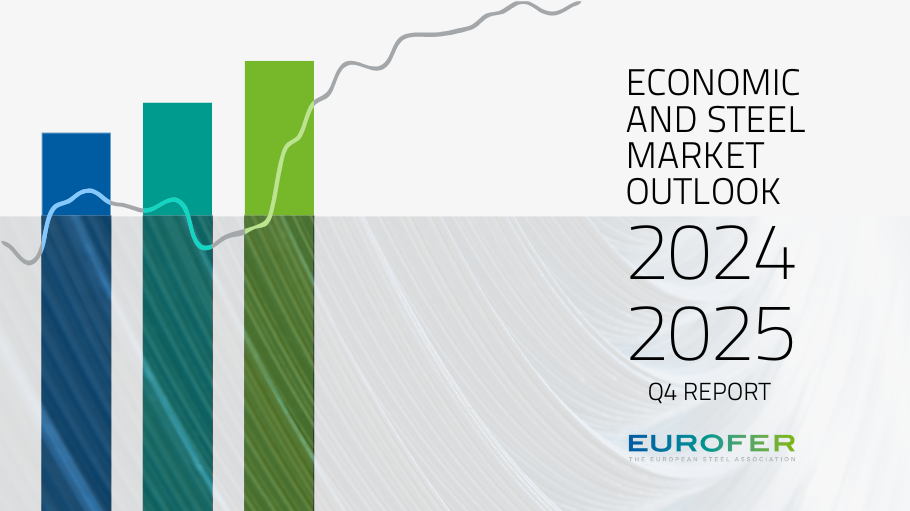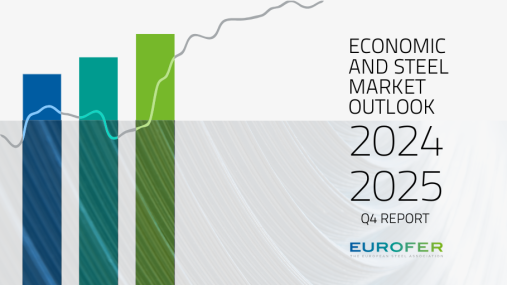
Press releases » Steel market outlook continues to worsen as demand and consumption decline amid high import shares
Steel market outlook continues to worsen as demand and consumption decline amid high import shares
Downloads and links
Recent updates

Brussels, 29 October 2024 – The European steel market faces an increasingly challenging outlook, driven by a combination of low steel demand, a downturn in steel-using sectors, and persistently high import shares. These factors, combined with a weak overall economic forecast, rising geopolitical tensions, and higher energy costs for the EU compared to other major economic regions, are further deepening the downward trend observed in recent quarters. According to EUROFER’s latest Economic and Steel Market Outlook, apparent steel consumption will not recover in 2024 as previously projected (+1.4%) but is instead expected to experience another recession (-1.8%), although milder than in 2023 (-6%). Similarly, the outlook for steel-using sectors’ output has worsened for 2024 (-2.7%, down from -1.6%). Recovery projections for 2025 are also more modest for both apparent consumption (+3.8%) and steel-using sectors’ output (+1.6%). Steel imports share rose to 28% in the second quarter of 2024.
“Such data further confirm the urgent need for action at EU level to preserve sustainable steel production and quality jobs in Europe while supporting decarbonisation investments. As highlighted in the recent debate at the European Parliament, we must urgently address global overcapacity and unfair trade practices, high energy prices and access to ferrous scrap alongside establishing lead markets for green steel made in Europe. We call on Members of the European Parliament and the incoming European Commission to deliver a robust European Steel Action Plan as a priority”, said Axel Eggert, Director General of the European Steel Association (EUROFER), following the publication of the Economic Report Q4 2024.
In the second quarter of 2024, apparent steel consumption decreased again (-1.3%, after -3%), reaching a total volume of 34.8 million tonnes. This downward trend is expected to continue throughout the year, contrary to earlier expectations of improved demand. The evolution of steel demand remains subject to high uncertainty and, even with a modest recovery projected in 2025 (+3.8%), consumption volumes are likely to remain well below pre-pandemic levels.
Similarly, domestic deliveries contracted again (-1.7%) in the second quarter, though less sharply than in the first quarter (-5.6%). In the same period, imports also decreased slightly (-1.5%), but their overall share has climbed to a historical high of 28%.
In the same period, steel-using sectors also experienced a notable decline for the second consecutive time (-2.1%, after -2.4%), after showing some resilience until the end of 2023 (+0.9%). This trend results from a general recession in all major steel-using sectors, including construction, mechanical engineering, domestic appliances, metalware, and now automotive, which has stalled after seven consecutive quarters of growth.
Despite three recent interest rate cuts by the European Central Bank (ECB), high economic uncertainty is likely to persist. The Steel Weighted Industrial Production index (SWIP) is projected to face a deeper-than-anticipated recession in 2024 (-2.7%, down from -1.6%), driven by declines in output in the construction and automotive sectors, with only a modest recovery expected in 2025 (+1.6%, down from +2.3%).
Contact
Lucia Sali, Spokesperson and Head of Communications, +32 2 738 79 35, (l.sali@eurofer.eu)
About the European Steel Association (EUROFER)
EUROFER AISBL is located in Brussels and was founded in 1976. It represents the entirety of steel production in the European Union. EUROFER members are steel companies and national steel federations throughout the EU. The major steel companies and national steel federation of Turkey, Ukraine and the United Kingdom are associate members.
The European Steel Association is recorded in the EU transparency register: 93038071152-83.
About the European steel industry
The European steel industry is a world leader in innovation and environmental sustainability. It has a turnover of around €191 billion and directly employs around 303,000 highly-skilled people, producing on average 140 million tonnes of steel per year. More than 500 steel production sites across 22 EU Member States provide direct and indirect employment to millions more European citizens. Closely integrated with Europe’s manufacturing and construction industries, steel is the backbone for development, growth and employment in Europe.
Steel is the most versatile industrial material in the world. The thousands of different grades and types of steel developed by the industry make the modern world possible. Steel is 100% recyclable and therefore is a fundamental part of the circular economy. As a basic engineering material, steel is also an essential factor in the development and deployment of innovative, CO2-mitigating technologies, improving resource efficiency and fostering sustainable development in Europe.

Strasbourg, 17 December 2025 – The European Commission’s latest proposals on the Carbon Border Adjustment Mechanism (CBAM), unveiled today, correctly identify several loopholes that risk undermining its effectiveness, notably regarding EU exports, downstream sectors and circumvention practices. However, despite these laudable efforts, the measures put forward fail to deliver a comprehensive and durable response to carbon and jobs leakage, warns the European Steel Association (EUROFER).
A milestone occasion to quickly and effectively restore affordable electricity, to relaunch the
decarbonization and strengthen the international competitiveness of the European steel
industry.
Brussels, 02 December 2025 – Unchanged negative conditions – U.S. tariffs and trade disruptions, economic and geopolitical tensions, protracted weak demand and still high energy prices – continue to weigh on the European steel market. EUROFER’s latest Economic and Steel Market Outlook confirms for 2025 another recession in both apparent steel consumption (-0.2%, unchanged) and steel-using sectors (-0.5%, revised from -0.7%). A potential recovery is expected only in 2026 for the Steel Weighted Industrial Production index (SWIP) (+1.8%, stable) and for apparent steel consumption (+3%, slightly revised from +3.1%) – although consumption volumes would still remain well below pre-pandemic levels. Steel imports retained historically high shares (27%), while exports plummeted (-9%) in the first eight months of 2025.